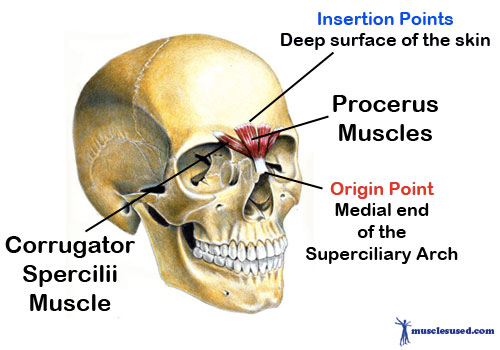
Many different muscles of the head are responsible for facial expressions such as smiling, frowning, anger, fear and surprise.
The human head can be divided into many different muscles groups differing in functions and actions. We will be examining the two main muscles of the head the Muscles of the face which are primarily responsible for our facial expressions and the muscles of mastication which are responsible for chewing. There are other important muscles located on or in the head such as the muscles of the tongue and throat and the extrinsic muscles of the eyes responsible for controlling the movement of our eyes, which we will not be discussing here.
Muscles of Facial Expression
The muscles of facial expression are extremely important muscles as they are chiefly responsible for communication between humans. You can generally see just from looking at from someone’s face whether they are feeling happy, surprised, angry, fearful, sad as well as many other emotions.These muscles of facial expression are extremely important in non verbal communication and are countlessly relied upon through out the day.
These muscles of facial expression are uniques as they generally originate from the skull, however unlike most skeletal muscles which insert to another bone, the muscles of facial expression insert into the superficial fascia and dermis of the skin and as a result when they contract, the skin moves. In the following we will detail the different facial expression muscles and their associated actions.
Muscles of the head

The Frontalis and Occipital muscles are responsible for the facial expression of surprise and fright
[ad name=”Footer Link”]
Frontalis and the Occipital Muscles
The Frontalis and Occipital muscles are part of the epicranius and primarily responsible to create the expressions of surprise and fright by tightening the entire scalp. The frontalis muscles as the name suggests in located in the anterior part of the epicanius. Its Origin point is out of muscles that are over the bridge of the nose and it’s insertion point is the posterior edge of the galea aponeruotica. The galea aponeurotica travels over the top of the skull until it meets the occipital muscle which is located near the rear or base of the scull. It’s origin point is along the superior nuchal line at the base of the occipital bone of the skull and courses upward to an insertion point at the posterior edge of the galea.
Muscles for Frowning
Corrugator Supercilii and Procerus Muscles
The Corrugator Supercilii and Procerus muscles are located where the top nose meets the forehead and are responsible for the expression of frowning. They have the same origin points at the frontalis muscle and insertion points just above the root of the nose.
Muscles for Blinking
Palperbral Levator Superioris Muscle
The palpebral levitator superior muscle or more commonly known as the levitator for short is the the muscle which lifts the upper eye lid in the second part of the blinking action and maintains the correct level of the upper lid when the eye is open. It has an origin point from the small wing of the sphenoid bone, at the apex of its orbit. The levitator ends as many tiny fiber-like attachments and has an insertion point at the inner surface of the skin of the upper eye lids forming the lid crease.

The Orbicularis Oculi muscle is responsible for closing your eyelids when blinking, winking and squinting
Orbicularis Oculi Muscle
The orbicular Oculi muscle is the muscle responsible for closing your eyelids when blinking and allowing you to squint or wink your eyes. It is made up of two portions the palpebral portion and the orbital portion. The Palpebral portion of the muscle is a thin layer which is essentially part of the eyelid and has an origin point from the frontal and maillary bones and the medial palpebral ligament, and forms a series of concentric curves around the eyeball and has an insertion point into the lateral palpebral raphia at the outer canthus of the eye. This portion of the muscle is primarily responsible for opening the eyelids. The orbital portion is the muscle that encircle the entire eye above and below with it’s fibers forming a complete ellipse around the eyeball with the upper fibers of the orbital portion blending with the Frontalis and Corrugator muscles.
Muscles for flaring your nose
Nasalis Muscle
The nasalis muscle is the muscle which is responsible for flaring your nostrils. It consists of two parts the Transverse part and the Altar part. The transverse part has an origin point from he maxilla above and lateral to the incisive fossa and an insertion point at the aponeurosis on the bridge of the nose. The altar part has its origin point at greater altar cartilage and an insertion point at thin aponeurosis on the bridge of the nose.
Depressor Septi Muscle
The depressor septi muscle is a small muscle responsible for drawing the nose downward. It has an origin point from the maxilla, just under the nose, and an insertion point at the septum of the nose.
Muscles of Facial Expression,



I just saw the eye one, so ignore that one.